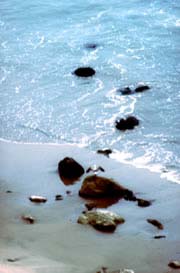Equatorial water belt slackens

Less carbon may have reached the atmosphere from the Pacific Ocean surface over the past two decades <br>© Noella Ballenger <br>
30 years of slowing Pacific circulation may have changed climate
A recent slowing in the circulation of Pacific Ocean waters could have raised Pacific sea surface temperatures. It may even mean that less carbon has reached the atmosphere from the ocean surface over the past two decades.
Across the Pacific, water circulates in two giant loops in the Northern and Southern Hemispheres. It flows from the subtropics to the tropics about at a depth of 100-400 metres, rises to the surface at the equator, and heads back towards the poles at the surface.
This circulation has changed since the 1970s, say Michael McPhaden of the Pacific Marine Environmental Laboratory, Seattle, Washington, and his colleague Dongxiao Zhang of the University of Washington in Seattle1. Thirty years down the line, the amount of subtropical water that reaches the equatorial Pacific sea surface has dropped by 25%.
It had already been noticed that the temperature of the sea surface at the equatorial Pacific has risen by 0.8 oC over the past 30 years. This had puzzled researchers, as cloudy skies in this area have become more frequent over the past 50 years, providing cooling shade. McPhaden and Zhang’s finding explains the warming: the supply of cool subtropical water has dropped.
Getting warmer
The warming that sluggish circulation has brought to the equatorial Pacific may have something to do with the shift in the mid-1970s towards stronger, longer and more frequent El Niño events, in which ocean temperatures and wind patterns fluctuate.
El Niño events cause erratic weather around the world, including droughts in Southeast Africa and floods in parts of South America. But the link between decade-long circulation changes and shifts in the three- to seven-year El Niño cycles needs further investigation.
Nor can connections to global warming be untangled yet. “The beauty of the study is that it works with observations. So we know that the slowing effect is real and not just speculation,” says Richard Kleeman, of the Center for Atmosphere Ocean Science, New York.
But it is too early, he thinks, to decide whether – or indeed how – the new results might tie in with the changing climate. “It is a very complex system,” he says.
One potential connection lies in the carbon cycle. “The tropical Pacific is the largest oceanic source of carbon dioxide to the atmosphere,” McPhaden and Zhang point out. The slowing circulation implies that less of this greenhouse gas has reached the ocean surface over the past decade. So, in the short term, the slowing circulation has helped to keep global warming at bay.
References
- McPhaden, M. J. & Zhang, D. Slowdown of the meridional overturning circulation in the upper Pacific Ocean. Nature, 415, 603 – 3608, (2002).
Media Contact
More Information:
http://www.nature.com/nsu/020204/020204-8.htmlAll latest news from the category: Earth Sciences
Earth Sciences (also referred to as Geosciences), which deals with basic issues surrounding our planet, plays a vital role in the area of energy and raw materials supply.
Earth Sciences comprises subjects such as geology, geography, geological informatics, paleontology, mineralogy, petrography, crystallography, geophysics, geodesy, glaciology, cartography, photogrammetry, meteorology and seismology, early-warning systems, earthquake research and polar research.
Newest articles

First-of-its-kind study uses remote sensing to monitor plastic debris in rivers and lakes
Remote sensing creates a cost-effective solution to monitoring plastic pollution. A first-of-its-kind study from researchers at the University of Minnesota Twin Cities shows how remote sensing can help monitor and…

Laser-based artificial neuron mimics nerve cell functions at lightning speed
With a processing speed a billion times faster than nature, chip-based laser neuron could help advance AI tasks such as pattern recognition and sequence prediction. Researchers have developed a laser-based…

Optimising the processing of plastic waste
Just one look in the yellow bin reveals a colourful jumble of different types of plastic. However, the purer and more uniform plastic waste is, the easier it is to…



